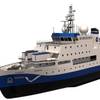Gladding-Hearn Shipbuilding has begun construction of its first water-jet-propelled pilot boat for the Galtex pilots in Galveston, Texas. Delivery is planned for March 2005. The shipyard is applying the experience of building more than 20 ferries with water jets to the new pilot boat. In selecting water jets over a traditional propeller-driven launch the Galtex pilots will avoid costly repairs to propellers and shafts from debris in Galveston harbor, particularly at high speeds, and enjoy improved maneuverability and safety during boarding and pilot rescues, said Peter Duclos, shipyard president.
Designed by C. Raymond Hunt Associates of Boston with its continually-evolving deep-V hull, the all-aluminum vessel measures 70 feet overall, with a 21-ft. beam and a shallow 3.9-ft. draft. The new design incorporates a fine entry forward with generous flare above the chines to provide a dry ride and extra buoyancy, Duclos explained. The hull design’s high dead-rise provides excellent handling at all speeds and directions to the sea. The wheelhouse is located well aft to improve the pilots’comfort at high speeds. The boat will also be equipped with a hydraulically adjustable interceptor-type trim control system.
It will be powered by twin Cummins KTA38-M2 diesel engines, each producing a conservative 1300 bhp at 1800 rpm and connected to a Hamilton HM 571 water jet. Each engine will turn a remote-mounted Reinjtes WVS 430/1 gearbox. Top speed is expected to reach 30 knots.
The engines feature Cummins’ Centinel oil lube management systems, which continually add fresh oil to replace oil burned through the fuel system. The Centinel systems combined with the Eliminator oil lube filtering systems lengthen oil change intervals to more than 4,000 operating hours, said Duclos.
The water jets, engines and gears will be controlled by the Hamilton Marine Electronic Control System (MECS) with the primary station in the wheelhouse and a hand-held remote aft at the rescue station.
The launch is equipped with wide side decks, side and rear doors, inverted front windows, and port and starboard boarding platforms. A recessed rescue platform will be built into the transom. A pipe davit, equipped with a self-tailing winch, will be welded in the vessel’s transom for pilot rescue operations.
Instruments in the wheelhouse include Furuno Navnet integrated radar, chart plotter, GPS and sounder with multiple displays, and four CCTV color cameras in the engine and water-jet rooms. The air-conditioned wheelhouse and finished forecastle feature nine Stidd recliners, cushioned settee and berth, dinette, and enclosed head. The galley is equipped with refrigerator, microwave, stainless steel sink, and hanging lockers and drawers. Interior sound levels are expected to be about 78 dbA.
Gladding-Hearn is also building two of its 53-ft. “Chesapeake” class vessels for the Portland and Delaware pilots and two 52-ft. “Jacksonville” class pilot boats for the Louisiana-based Associated Branch Pilots, who serve the southwest pass of the Mississippi River.
Subscribe for
Maritime Reporter E-News
Maritime Reporter E-News is the maritime industry's largest circulation and most authoritative ENews Service, delivered to your Email five times per week










